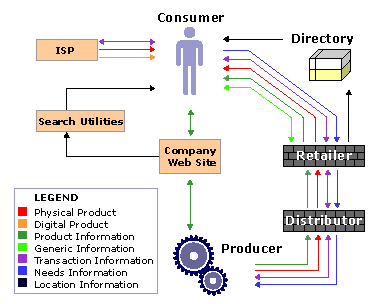The main thrust of the static stage was the distribution of product information and FAQs, so companies created company websites just
for that purpose. The traditional distribution channels were still in place, but now product information was flowing directly from the
producer to the consumer via the company website. This dissociation had two profound implications:
| Lesson 6 | Static stage |
| Objective | Describe the static market flow stage. |
Static Market Flow Stage
The first change emerging from the technical evolution leading to the browser and Web server was the dissociation of product information from the flows of physical product.

- Unfiltered (not "creatively enhanced") products became available to consumers directly from the producer.
- Consumers could choose from multiple sources of information and not only were consumers able to obtain just the information the company published, but also information published by competitors. The easy availability of information led to a more educated, value-conscious consumer.
How Mobile has changed ecommerce?
The changing mobile landscape, and newer web technologies, means that working with mobile commerce requires a new approach to an old problem.
This tutorial will take you through the steps to create a simple mobile commerce site that provides an interactive shopping experience over low-bandwidth
connections. Part one of this tutorial will walk you through using PHP5, jQuery, and Taffy DB to create an interactive product catalog. Part two of this
tutorial will walk you through using an HTML5 database to store a shopping cart and show you how to submit the shopping cart to a server at the time of
checkout.
Information Sources
Information sources sprouted on the Web, now producers needed a way to capture the attention of consumers.
Just as retailers in the brick and mortar world needed a directory for consumers to find them, company sites, which exist in the cyber world, needed a directory for consumers to find them in cyberspace. What emerged was another role of a utility, directory services and search engines.
Therefore, Yahoo, Excite, and Alta Vista emerged. All of these are search engines that allow consumers to find companies.
A third role that developed was that of ISPs (Internet service providers). ISPs provide the physical product of bandwidth to the consumer and the digital product of access to the consumer.
The consumer transacts and purchases these products directly from the ISP. At this stage the Web was being viewed as simply an information distribution channel and had no major impact on traditional delivery mechanisms.
A third role that developed was that of ISPs (Internet service providers). ISPs provide the physical product of bandwidth to the consumer and the digital product of access to the consumer.
The consumer transacts and purchases these products directly from the ISP. At this stage the Web was being viewed as simply an information distribution channel and had no major impact on traditional delivery mechanisms.